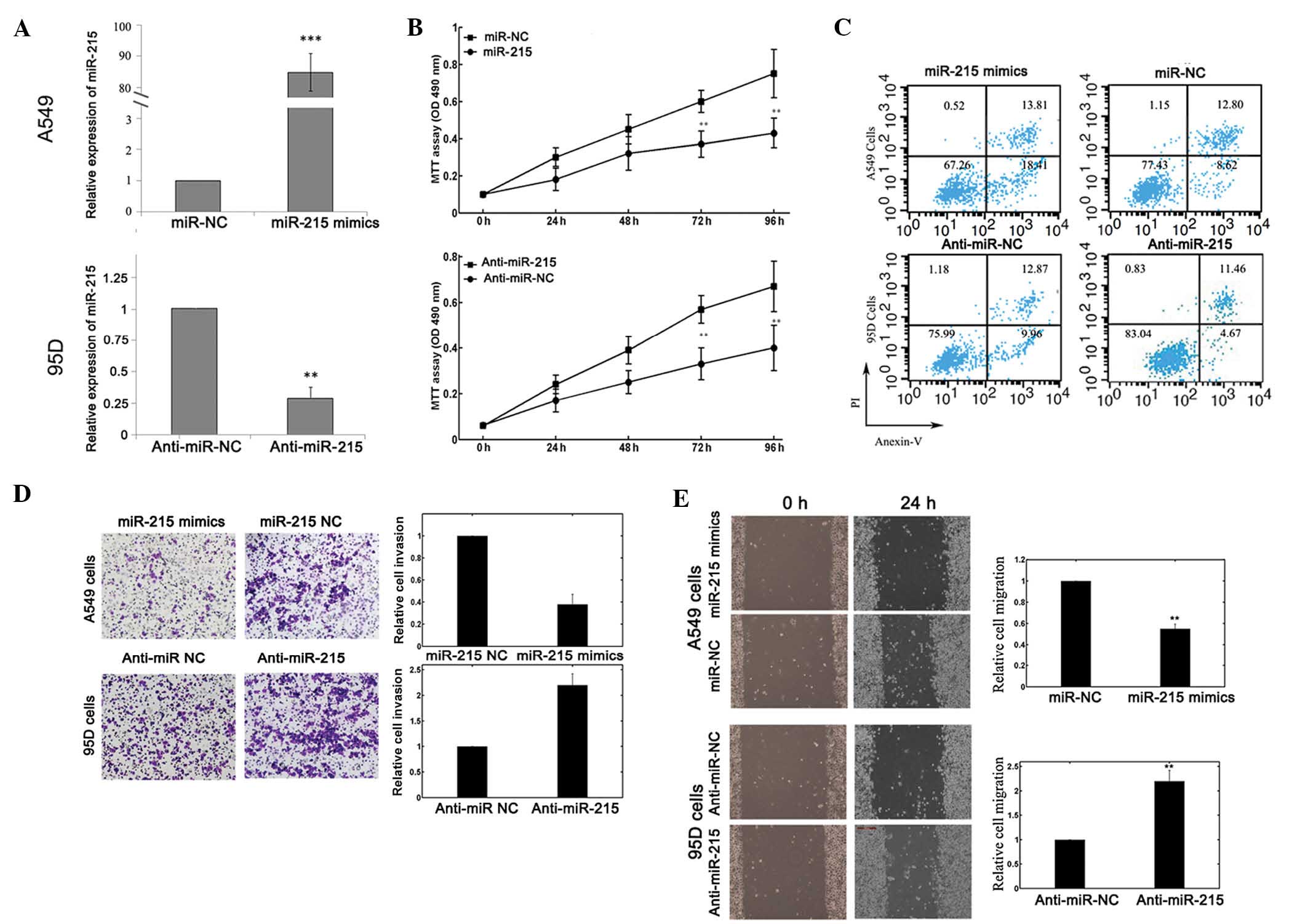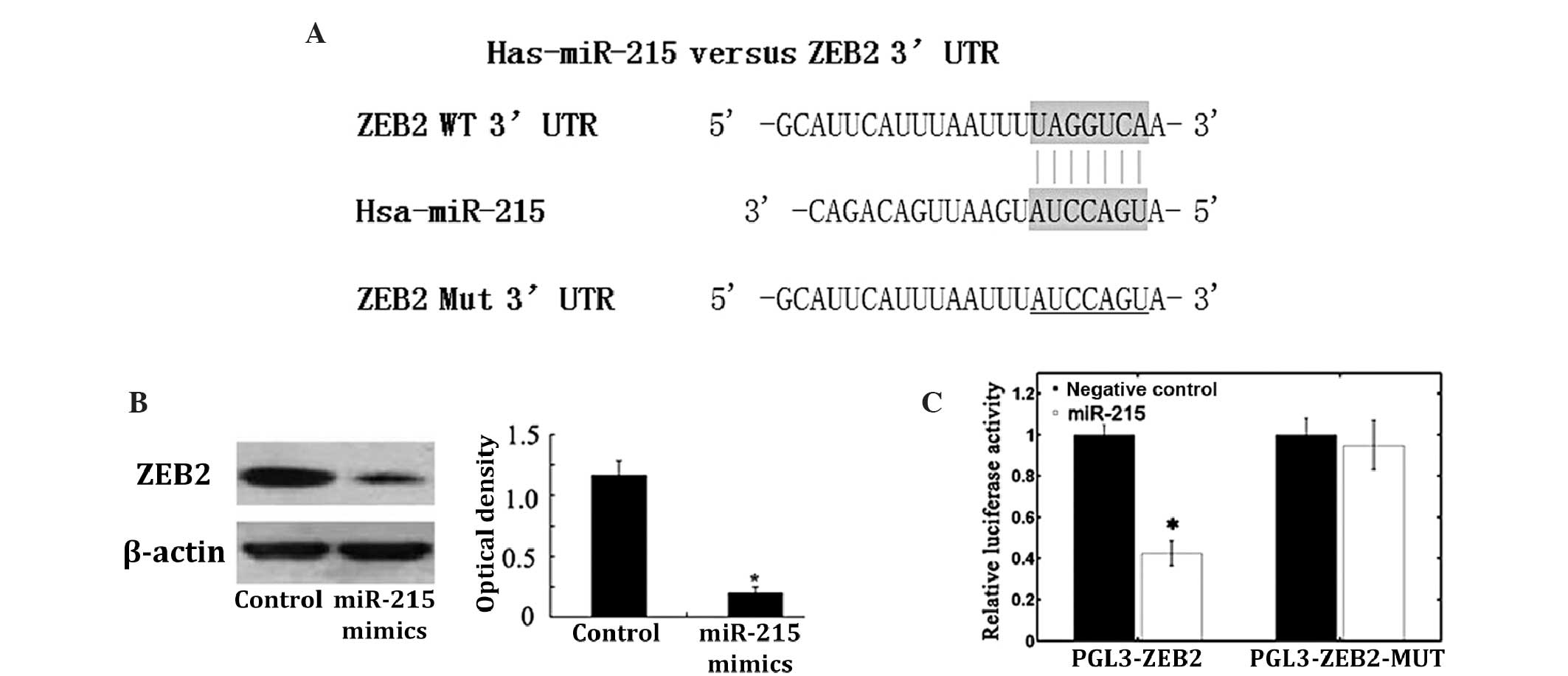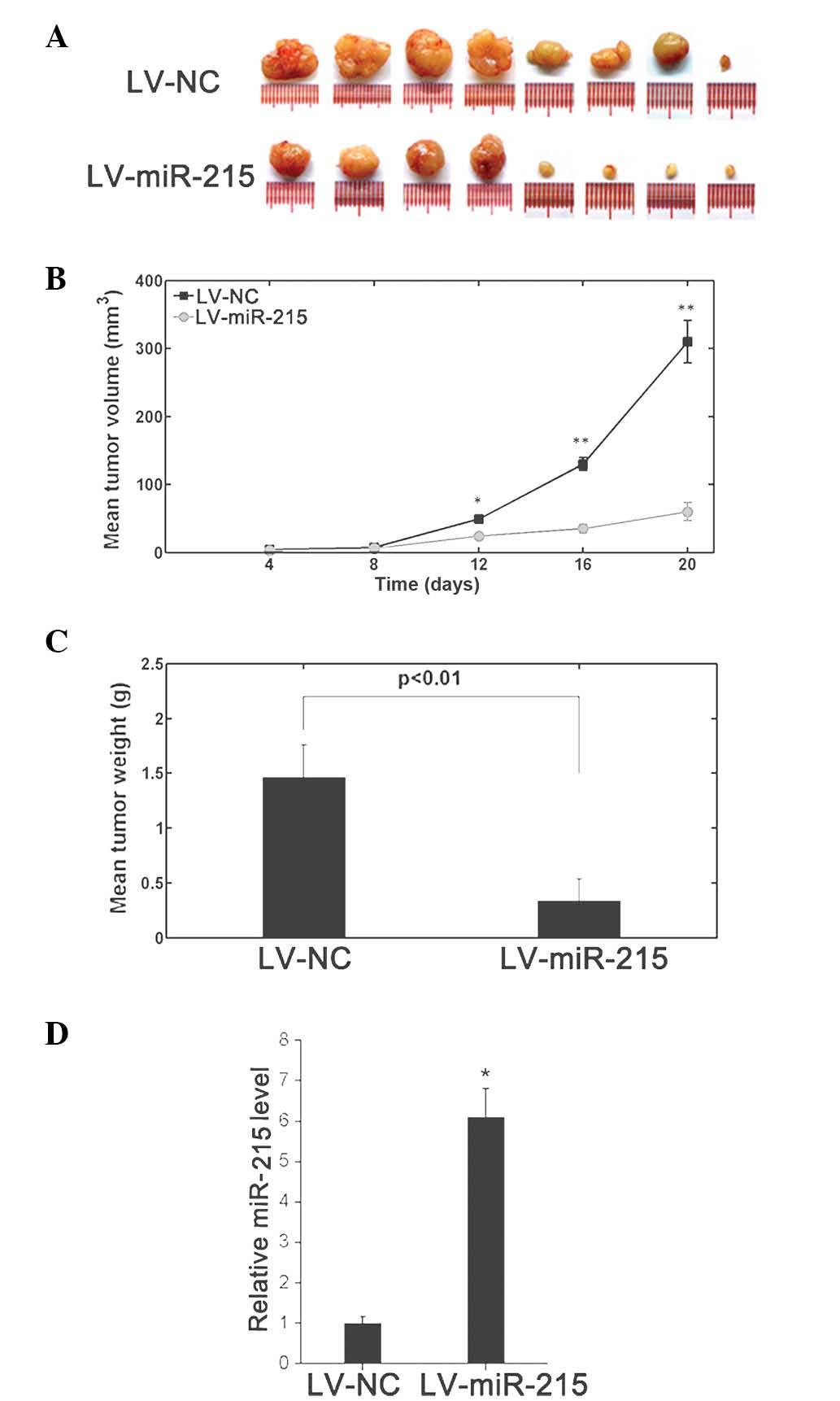|
1
|
Jemal A, Siegel R, Xu J and Ward E: Cancer
statistics, 2010. CA Cancer J Clin. 60:277–300. 2010. View Article : Google Scholar : PubMed/NCBI
|
|
2
|
Jemal A, Siegel R, Ward E, Murray T, Xu J,
Smigal C and Thun MJ: Cancer statistics, 2006. CA Cancer J Clin.
56:106–130. 2006. View Article : Google Scholar : PubMed/NCBI
|
|
3
|
Ma Q, Jiang Q, Pu Q, Zhang X, Yang W, Wang
Y, Ye S, Wu S, Zhong G, Ren J, et al: MicroRNA-143 inhibits
migration and invasion of human non-small-cell lung cancer and its
relative mechanism. Int J Biol Sci. 9:680–692. 2013. View Article : Google Scholar : PubMed/NCBI
|
|
4
|
Yin LG, Zou ZQ, Zhao HY, Zhang CL, Shen
JG, Qi L, Qi M and Xue ZQ: Analysis of tissue-specific
differentially methylated genes with differential gene expression
in non-small cell lung cancer. Mol Biol (Mosk). 48:797–804.
2014.(In Russian). View Article : Google Scholar : PubMed/NCBI
|
|
5
|
Zhao X, Zhang Z, Yuan Y and Yuan X:
Polymorphisms in ERCC1 gene could predict clinical outcome of
platinum-based chemotherapy for non-small cell lung cancer
patients. Tumour Biol. 35:8335–8341. 2014. View Article : Google Scholar : PubMed/NCBI
|
|
6
|
Yoo SS, Lee SM, Do SK, Lee WK, Kim DS and
Park JY: Unmethylation of the CHRNB4 gene is an unfavorable
prognostic factor in non-small cell lung cancer. Lung Cancer.
86:85–90. 2014. View Article : Google Scholar : PubMed/NCBI
|
|
7
|
Bartel DP: MicroRNAs: Target recognition
and regulatory functions. Cell. 136:215–233. 2009. View Article : Google Scholar : PubMed/NCBI
|
|
8
|
Bartel DP: MicroRNAs: Genomics,
biogenesis, mechanism, and function. Cell. 116:281–297. 2004.
View Article : Google Scholar : PubMed/NCBI
|
|
9
|
Heneghan HM, Miller N and Kerin MJ: MiRNAs
as biomarkers and therapeutic targets in cancer. Curr Opin
Pharmacol. 10:543–550. 2010. View Article : Google Scholar : PubMed/NCBI
|
|
10
|
Liang H, Li Y, Luo RY and Shen FJ:
MicroRNA-215 is a potential prognostic marker for cervical cancer.
J Huazhong Univ Sci Technolog Med Sci. 34:207–212. 2014. View Article : Google Scholar : PubMed/NCBI
|
|
11
|
Liu F, You X, Chi X, Wang T, Ye L, Niu J
and Zhang X: Hepatitis B virus X protein mutant HBxΔ127 promotes
proliferation of hepatoma cells through up-regulating miR-215
targeting PTPRT. Biochem Biophys Res Commun. 444:128–134. 2014.
View Article : Google Scholar : PubMed/NCBI
|
|
12
|
Deng Y, Huang Z, Xu Y, et al: MiR-215
modulates gastric cancer cell proliferation by targeting RB1.
Cancer Lett. 342:27–35. 2014. View Article : Google Scholar : PubMed/NCBI
|
|
13
|
Walter BA, Valera VA, Pinto PA and Merino
MJ: Comprehensive microRNA profiling of prostate cancer. J Cancer.
4:350–357. 2013. View
Article : Google Scholar : PubMed/NCBI
|
|
14
|
Wijnhoven BP, Hussey DJ, Watson DI, Tsykin
A, Smith CM and Michael MZ: South Australian Oesophageal Research
Group: MicroRNA profiling of Barrett's oesophagus and oesophageal
adenocarcinoma. Br J Surg. 97:853–861. 2010. View Article : Google Scholar : PubMed/NCBI
|
|
15
|
Karaayvaz M, Pal T, Song B, et al:
Prognostic significance of miR-215 in colon cancer. Clin Colorectal
Cancer. 10:340–347. 2011. View Article : Google Scholar : PubMed/NCBI
|
|
16
|
White NM, Khella HW, Grigull J, et al:
miRNA profiling in metastatic renal cell carcinoma reveals a
tumour-suppressor effect for miR-215. Br J Cancer. 105:1741–1749.
2011. View Article : Google Scholar : PubMed/NCBI
|
|
17
|
De Craene B and Berx G: Regulatory
networks defining EMT during cancer initiation and progression. Nat
Rev Cancer. 13:97–110. 2013. View
Article : Google Scholar : PubMed/NCBI
|
|
18
|
Comijn J, Berx G, Vermassen P, et al: The
two-handed E box binding zinc finger protein SIP1 downregulates
E-cadherin and induces invasion. Mol Cell. 7:1267–1278. 2001.
View Article : Google Scholar : PubMed/NCBI
|
|
19
|
Usova EV, Kopantseva MR, Kostina MB,
Vankovich AN, Egorov VI and Kopantsev EP: Expression of the ZEB2
gene in pancreatic stromal cells in pancreatic ductal
adenocarcinoma, pancreatitis, and normal state. Dokl Biol Sci.
448:61–64. 2013. View Article : Google Scholar : PubMed/NCBI
|
|
20
|
Fang Y, Wei J, Cao J, et al: Protein
expression of ZEB2 in renal cell carcinoma and its prognostic
significance in patient survival. PLoS One. 8:e625582013.
View Article : Google Scholar : PubMed/NCBI
|
|
21
|
Lee H, Jun SY, Lee YS, Lee HJ, Lee WS and
Park CS: Expression of miRNAs and ZEB1 and ZEB2 correlates with
histopathological grade in papillary urothelial tumors of the
urinary bladder. Virchows Arch. 464:213–220. 2014. View Article : Google Scholar : PubMed/NCBI
|
|
22
|
Fang S, Zeng X, Zhu W, Tang R, Chao Y and
Guo L: Zinc finger E-box-binding homeobox 2 (ZEB2) regulated by
miR-200b contributes to multi-drug resistance of small cell lung
cancer. Exp Mol Pathol. 96:438–444. 2014. View Article : Google Scholar : PubMed/NCBI
|
|
23
|
You J, Li Y, Fang N, et al: MiR-132
suppresses the migration and invasion of lung cancer cells via
targeting the EMT regulator ZEB2. PLoS One. 9:e918272014.
View Article : Google Scholar : PubMed/NCBI
|
|
24
|
Zheng YB, Luo HP, Shi Q, et al: miR-132
inhibits colorectal cancer invasion and metastasis via directly
targeting ZEB2. World J Gastroenterol. 20:6515–6522. 2014.
View Article : Google Scholar : PubMed/NCBI
|
|
25
|
Guan H, Liang W, Xie Z, et al:
Down-regulation of miR-144 promotes thyroid cancer cell invasion by
targeting ZEB1 and ZEB2. Endocrine. 48:566–574. 2015. View Article : Google Scholar : PubMed/NCBI
|
|
26
|
Lu YM, Shang C, Ou YL, et al: miR-200c
modulates ovarian cancer cell metastasis potential by targeting
zinc finger E-box-binding homeobox 2 (ZEB2) expression. Med Oncol.
31:1342014. View Article : Google Scholar : PubMed/NCBI
|
|
27
|
Chiang Y, Song Y, Wang Z, et al:
microRNA-192, -194 and -215 are frequently downregulated in
colorectal cancer. Exp Ther Med. 3:560–566. 2012.PubMed/NCBI
|
|
28
|
Li S, Gao J, Gu J, Yuan J, Hua D and Shen
L: MicroRNA-215 inhibits relapse of colorectal cancer patients
following radical surgery. Med Oncol. 30:5492013. View Article : Google Scholar : PubMed/NCBI
|
|
29
|
Song B, Wang Y, Titmus MA, Botchkina G,
Formentini A, Kornmann M and Ju J: Molecular mechanism of
chemoresistance by miR-215 in osteosarcoma and colon cancer cells.
Mol Cancer. 9:962010. View Article : Google Scholar : PubMed/NCBI
|
|
30
|
Liu GF, Tang D, Li P, et al: S-1-based
combination therapy vs S-1 monotherapy in advanced gastric cancer:
A meta-analysis. World J Gastroenterol. 20:310–318. 2014.
View Article : Google Scholar : PubMed/NCBI
|
|
31
|
Jin Z, Selaru FM, Cheng Y, et al:
MicroRNA-192 and -215 are upregulated in human gastric cancer in
vivo and suppress ALCAM expression in vitro. Oncogene.
30:1577–1585. 2011. View Article : Google Scholar : PubMed/NCBI
|
|
32
|
Senanayake U, Das S, Vesely P, et al:
miR-192, miR-194, miR-215, miR-200c and miR-141 are downregulated
and their common target ACVR2B is strongly expressed in renal
childhood neoplasms. Carcinogenesis. 33:1014–1021. 2012. View Article : Google Scholar : PubMed/NCBI
|
|
33
|
Brennecke J, Stark A, Russell RB and Cohen
SM: Principles of microRNA-target recognition. PLoS Biol.
3:e852005. View Article : Google Scholar : PubMed/NCBI
|
|
34
|
Krek A, Grün D, Poy MN, Wolf R, et al:
Combinatorial microRNA target predictions. Nat Genet. 37:495–500.
2005. View
Article : Google Scholar : PubMed/NCBI
|
|
35
|
Zhao W, Huang CC, Otterson GA, Leon ME,
Tang Y, Shilo K and Villalona MA: Altered p16(INK4) and RB1
expressions are associated with poor prognosis in patients with
nonsmall cell lung cancer. J Oncol. 2012:9574372012. View Article : Google Scholar : PubMed/NCBI
|
|
36
|
Wu GQ, Liu NN, Xue XL, Cai LT, Zhang C, Qu
QR and Yan XJ: Multiplex real-time PCR for RRM1, XRCC1, TUBB3 and
TS mRNA for prediction of response of non-small cell lung cancer to
chemoradiotherapy. Asian Pac J Cancer Prev. 15:4153–4158. 2014.
View Article : Google Scholar : PubMed/NCBI
|
|
37
|
Ishiguro F, Murakami H, Mizuno T, et al:
Membranous expression of activated leukocyte cell adhesion molecule
contributes to poor prognosis and malignant phenotypes of
non-small-cell lung cancer. J Surg Res. 179:24–32. 2013. View Article : Google Scholar : PubMed/NCBI
|
|
38
|
Tachezy M, Zander H, WoltersEisfeld G, et
al: Activated leukocyte cell adhesion molecule (CD166): An ‘inert’
cancer stem cell marker for non-small cell lung cancer? Stem Cells.
32:1429–1436. 2014. View Article : Google Scholar : PubMed/NCBI
|













